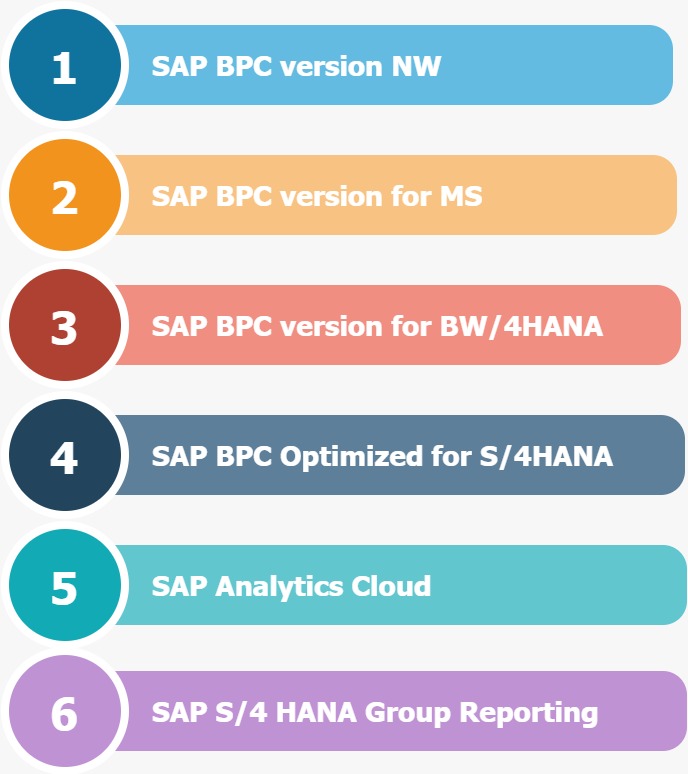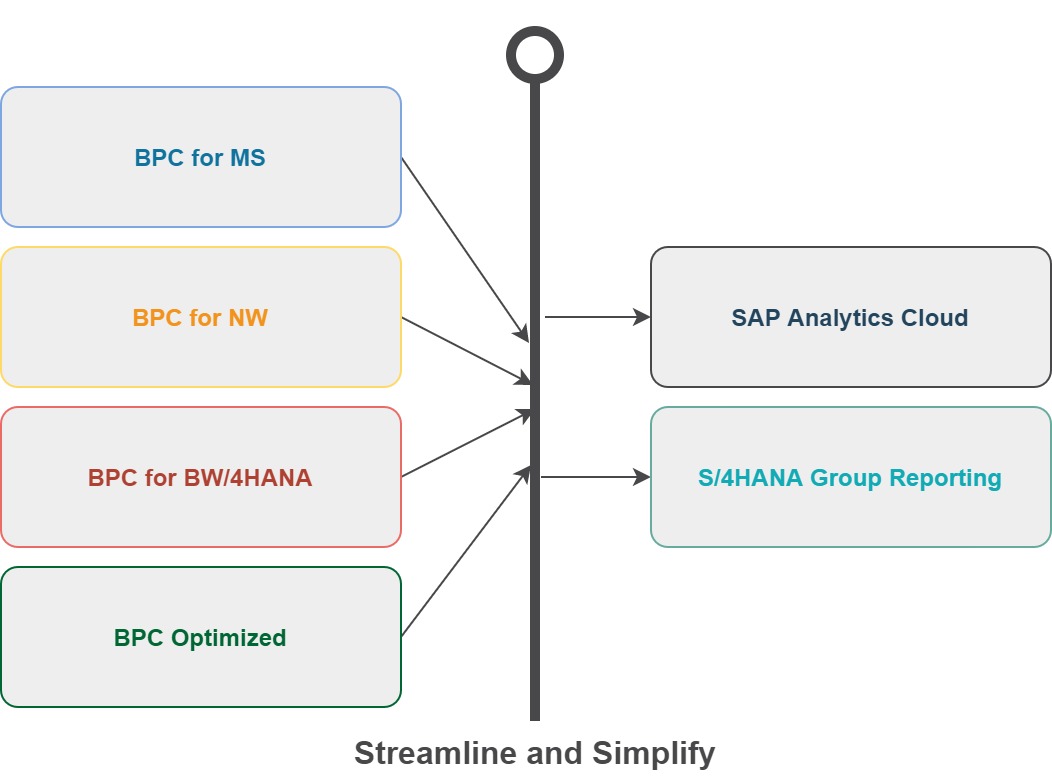It has been slightly over a decade since I started my journey with BPC. BPC has taken many twists and turns with its evolution, to arrive at where it is today. Its latest version is called BPC 11.x for BW/4HANA. However, there have been transformational changes happening, as you read in this blog, to the entire SAP EPM product portfolio. SAP has released several versions of BPC over the years, but calling them flavours, in my opinion, is more apt than calling them versions.
Before examining the question of whether or not BPC is still relevant, which is the premise of this undertaking, it is essential to wrap some context around that question. Let’s begin with a bit of background on BPC and its peers.
Flavours
As outlined in the infographic below, you may see that there are several flavours of BPC or similar products such as SAP Analytics Cloud or Group Reporting. Addressing the question of why calling them flavours is more apt, is because each flavour has its own set of versions (for example, SAP BPC 11.x for BW/4HANA) and allows us to understand them better.
BPC Microsoft version:
This is the version that SAP originally bought from Outlooksoft and continued to update and support until SAP BPC 10.1 for MS. However, SAP’s strategy is not to develop the product beyond version 10.1.
BPC NetWeaver (NW) version:
Built on top of BW NetWeaver technology, this flavour of BPC was first introduced with the version 7.0. Subsequently, it took the forms 7.5, 10.0, and 10.1.
From the 10.1 version, SAP has further divided this BPC NetWeaver flavour into two additional flavours – Standard and Embedded. 10.1 is the last NetWeaver version of BPC with both Standard and Embedded flavours.
BPC version for BW/4HANA:
From the features and functionality perspective, this version of BPC is no different from its predecessor (10.1 NW). However, it is not on NetWeaver technology; instead, it is on BW/4HANA. This flavour of BPC has been given a version number 11.x (a logical numbering after 10.x, I guess). It also has been divided into Standard and Embedded flavours.
BPC Optimized for S/4HANA:
Also known as “BPC Optimized”, is yet another flavour of the BPC 10.1 Embedded version that is optimized for S/4HANA. Here SAP tried to bring in the functionality of Financial Consolidation systems much closer to related transactional systems, in order to achieve the lofty goal (at that time) of Real-Time Consolidation (RTC). Most of us are aware that it is not a popular product out there, probably the reason why its end of mainstream maintenance is fast approaching, with a development freeze announced a couple of years ago. We also need to bear in mind that ‘BPC Optimized’ is only available in the BPC 10.1 version (no support for 11.x).
SAP Analytics Cloud (SAC):
SAP’s crowning achievement so far, in this area, is an advanced analytics product that also provides planning and application development capabilities, has been launched a few years ago as a SaaS (Software as a Service) product. As per SAP’s roadmap, SAC is the go-to product for all of our analytical and planning needs.
S/4HANA Group Reporting:
This is SAP’s latest effort to unify Financial-Close processes and eliminate the need for multiple systems. This product lives much closer to the transactional processing systems and drives organizations to improve data quality and accelerate Financial-Close processes.
Versions
The following picture depicts several versions of BPC and its strategic transformation into next-generation products – SAC and Group Reporting.
At this point, we need to provide due consideration to the following points:
- For versions 7.0, 7.5, and 10.0 SAP released Microsoft and NetWeaver flavours (did you understand why I was advocating the differentiation between versions and flavours?)
- With its 10.1 version, SAP released ‘Embedded’ and ‘BPC Optimized’ for S/4HANA flavours along with Microsoft and NetWeaver (a.k.a. Standard) flavours
- 10.1 version is the last version for both Microsoft and BPC Optimized for S/4HANA flavours
- 11.x version is the latest version that is explicitly built for BW/4HANA – it is a prerequisite
- SAC is the latest Business Intelligence, Planning, and Predictive Analytics tool – it is a SaaS (Software as a Service) tool available on-cloud
- S/4HANA Group Reporting is the newest tool for Financial Consolidation that allows Real-Time Consolidation – available on-cloud and on-prem
What’s Next?
Anyone reading the list of flavours vs versions that SAP provides might think this list is enough to confuse customers and consultants alike. However, by providing these variations, SAP has been serving customers based on their specific requirements. For example, suppose a customer is not an SAP-house and do not want to procure BW just for the sake of running SAP EPM, such customers always have an option to go with BPC version for Microsoft. In such cases, it is a boon to customers who want to reduce the TCO (total cost of ownership).
There has been a lot of innovation at SAP lately, which has resulted in a set of next-generation products such as SAP Analytics Cloud and S/4HANA Group Reporting. These new products have consolidated several tools that exist in SAP’s product portfolio – as depicted in the image below.
As per SAP’s roadmap, SAC is the go-to tool for all reporting and analytical/s needs. Similarly, from a planning and consolidation point of view, the go-to products are SAC and Group Reporting, respectively. As per the image below, it can be observed that all BPC flavours are consolidated into SAC and S/4HANA Group Reporting.
So, is that it? Can we say good-bye to BPC?
NO… I do not think so. BPC is a single tool that allows customers to implement both Planning as well as Financial Consolidations. This product has been in the market for over 13 years and counting. On the other hand, SAC for planning is the new kid on the block, providing planning features along with advanced analytical/s features.
As to the rationale I’ve adopted to arrive at this conclusion, the following could be why SAP BPC is still an important option for customers with greenfield implementation scenarios or an upgrade from BPC 10.1 NW to the latest 11.x for BW/4HANA.
- BPC provides Financial Consolidations functionality along with enterprise-level planning, budgeting, and forecasting capabilities. On the other hand, SAC is providing some features related to planning but does not support Financial Consolidations yet; S/4HANA Group Consolidation is the proposed/go-to tool for that purpose.
- If budget/forecast data does not have to be consolidated, the approach of having different products can be pursued. ? In situations where such consolidation is required, there is a need to move data from one tool to the other. ? BPC, having the ability to perform consolidations as well, has seamless integration with both sets of data.
- The Technology Roadmap of SAP BPC 11.x for BW/4HANA shows that SAP is actively investing time and effort on its development and in the addition of new features along with its integration with SAC.
- SAP’s roadmap alludes to “extending SAP Business Planning & Consolidation with SAP Analytics Cloud” – Click here to know more.
- SAP BPC can implement complex business scenarios such as Security, Custom Business Logic, Workflow, Data Transformation, Data Locking, etc., with the help of a variety of available programming/scripting languages. The following options are available based on the flavour/version of BPC that is being implemented – Logic Scripts, BAdIs, ABAP, FOX Scripts, and AMDP/HANA SQL.
- The BPC ecosystem that has been built for over a decade-and-half provides a lot of support and guidance during implementation and BAU (Business-as-Usual) of BPC applications. Resource availability, technology know-how, etc., have an impact on the TCO (Total Cost of Ownership) and faster RoI (Return on Investment).
- Feature maturity of SAC and S/4HANA Group Reporting, at the time this is being written and shared, is not on par with that of BPC for Planning and Financial Consolidations, respectively. However, this situation is strongly expected to change with time as SAP’s strategy clearly suggests that SAC and Group Reporting are the go-to products for planning and consolidations, respectively.
- As they say, “a known devil is better than an unknown angel”. Thousands of referenceable customers of SAP BPC are always a comforting factor to new/existing customers implementing or enhancing planning and consolidation applications.
If you are an existing BPC customer with S/4HANA and SAC on your organization’s technology strategy roadmap, it is worth considering the use of SAC in combination with BPC (as suggested in point-4 above) to achieve a smooth transition over a period of time.
Powered by Froala Editor




Write A Comment